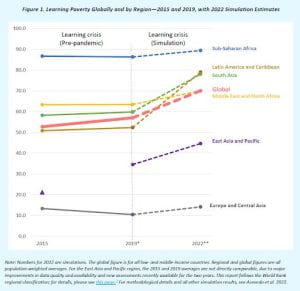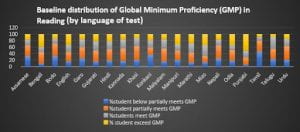सुखार्थिन: कुतो विद्या विद्यार्थिन: कुतो: सुखम् ।
सुखार्थी वा त्यजेत् विद्यां विद्यार्थी वा त्यजेत् सुखम् ।।
The above lines represent a couplet in Sanskrit. Were you able to read it? Were you able to comprehend it?
Probably not!
Let’s try another one:
Sukharthinah kutovidya vidyarthinah kuto sukham.
Sukharthi vaa tyajet vidyam, vidyarthi vaa tyajet sukham
Now? More of us can now probably read it but still may not be able to comprehend it. Doesn’t this make you feel weird? You want to understand it, make sense of it, but you can’t!
Imagine a similar scenario, but for 10-year-old children from low and middle-income countries trying to read way simpler texts in their local language. If you can’t read and comprehend, you lose a major opportunity to learn. If you can’t read and comprehend at the right level, you end up playing catch-up forever!
As per the World Bank report: The State of Global Learning Poverty, 2022 – 6 out of every 10 ten-year-olds in low-and middle-income countries were suffering from learning poverty in 2019. The situation, as we all know, only worsened with COVID-19. Learning Poverty is defined as being unable to read and understand a short, age-appropriate text by age 10. The World Bank report states that without adequate action, the current generation of students now risks losing ~ $21 trillion in lifetime earnings in present value, or the equivalent of 17 percent of 2022’s global GDP.

Source: State of Global Learning Poverty, Update 2022
The figure above shows the average percentage of 10-year-old children from each geographic region, who face learning poverty [5]. The inequality is evident. While all countries face an increase post-pandemic, most developing regions face a sizeable gap (>50%) from their developed counterparts. Globally, countries are working towards respective national targets to achieve a 50% reduction in average global learning poverty by 2030 (SDG 4).
Through this blog, I want to highlight India’s recent education policy reforms that align with SDG 4 and the implementation challenges. According to the World Bank report, India’s learning poverty rate was at 56.1% pre-pandemic. According to the Annual Status of Education Report 2022, 80% of students in Grade 3 in schools in rural India could not read a Grade 2 text and 74% of students in Grade 3 in schools in rural India could not do simple subtraction.
In the last five years, India has undertaken two major educational policy initiatives – National Education Policy (NEP) 2020, and Nipun Bharat Mission 2021 with a focus on foundational literacy and numeracy. The NEP 2020 was a much-awaited reformation in the form of umbrella policy guidelines for education at all levels in India. It specifically highlighted that achieving Foundational Literacy and Numeracy (FLN) by all students by Grade 3 will be accorded the highest priority. Calling upon an existing infrastructure of primary schools and public early childhood care centers (Anganwadi centers) in India the policy set out a goal to “achieve universal quality pre-school education, as soon as possible, no later than 2030”. As a follow-up on NEP 2020, the Ministry of Education, India launched the national mission on FLN – NIPUN (National Initiative for Proficiency in Reading with Understanding and Numeracy) Bharat in 2021. “Nipun” also doubles as a Hindi word that means ‘expert’ or ‘qualified’. The NIPUN Bharat mission, in other words, envisions a qualified India! It lays down priorities and actionable agendas for states/union territories to attain universal FLN by 2025 along with close tracking and monitoring of the progress.
In the past two years of such increased focus on FLN, India has seen several encouraging success stories. As per an article by Central Square Foundation (a leading non-profit in the education sector in India that actively collaborates with local district and state governments for implementation of FLN initiatives), the initiative has shown promising developments in a few states like Uttar Pradesh, Tamil Nadu, and Assam. For example, the CSF blog [7] discussed how a 60-day targeted FLN program in the Pune district in India resulted in an 8% increase in the students moving from intermediate to advanced proficiency in FLN competencies. Several such local and national initiatives are being implemented to bring together common resources for various stakeholders – school authorities, government officers, parents, and teachers/facilitators. At the national level, DIKSHA [8], an open-resource web portal provides useful standardized resources in terms of teacher training modules, teaching-learning material for pre-school and primary school kids, and community engagement modules.
Having said that, one must bear in mind that the implementation of the mission is a state government responsibility. Therefore, there is a lot of heterogeneity in the way different states are approaching the mission. The policy implementation must be monitored regularly at the center, otherwise, the state-wide heterogeneity may persist, and India may only reduce overall learning poverty and not the learning inequality!
Regular data and monitoring are important to inform and improve any policy implementation process. In a first-of-its-kind initiative, a large-scale Foundational Learning Study (covering 86000 students pan India) was conducted by the National Council of Education Research and Training, India in collaboration with UNICEF, in March 2022 to collect baseline data for the mission and set benchmark measures to compare progress with global proficiency levels in reading and numeracy.

Source: Foundational Learning Study, 2022
The above graph depicts the baseline distribution of performance in reading (prepared by the author) using data from the large-scale benchmarking survey. The survey was conducted in 20 languages and hence is not representative of any state’s performance. The graph shows that roughly 50-55% of students are below the Global minimum proficiency level in reading, on average. We can see that performance in some languages is slightly better than others, and hence there is scope of learning across regions to enhance the improvement in foundational literacy and numeracy.
If such data were collected and published year-on-year, it would be interesting to measure the interim success of the mission. While the full data set is not available on any open web-source, the report suggests efficient benchmarking across languages, which would facilitate scientific impact evaluation after the policy has been completely implemented. Overall, a more transparent data collection and reporting process can help foster more research around the feasibility of the mission and hold the stakeholders accountable.
Lastly, to speed up the implementation process there is a need for buy-in from local bodies on the importance of the policy and effective collaboration across states and non-for-profits to re-use existing material and prevent re-inventing the wheel. The government portal [8] provides useful standardized resources in terms of teacher training modules, teaching learning material for pre-school and primary school kids and community engagement modules. But there is a need to replicate the material in local languages and increase engagement with the resources through adequate publicity.
In a survey of 450 respondents in a district in Bihar, India
only 40% of the early childhood care practitioners
report that they know about/have heard of the Nipun Bharat mission!
While I spent my summer (2023) surveying some early childhood caretakers/teachers in a district in Bihar (for a different project), I was curious to measure the extent to which stakeholders at the local community level know about this national mission. I was surveying Anganwadi workers, who cater to 3–6-year-old children in the form of nutrition and pre-school education. It is natural to expect them to be informed about this national mission which directly relates to their beneficiary group. I was taken by surprise when I found out that of 450 respondents, only 40% of these early childhood caretakers report having heard about the Nipun Bharat mission!
Since government schools do not usually accommodate students younger than 6 years, and not all parents can afford private pre-schools, there is a big opportunity and responsibility to harness the existing public early childhood infrastructure in India (Anganwadi system) to make children school-ready as they embark on their journey to literacy.
Thus, while the initial planning for the mission has been powerful there is a need for a big push towards the execution of the policy mandates and tracking whether milestones are being achieved timely. Alongside collaboration on the educational resources, propagation of its availability at the rural community level, with stronger engagement among non-profits and local government bodies is crucial to make this mission a reality by 2025.
And now, I would like to leave you with the translated meaning of the Sanskrit couplet –
How can he who is after comforts have knowledge? How can he who seeks knowledge have comforts? Either one seeking comforts must give up knowledge or one seeking knowledge will have to give up comforts.
Thank you for reading!
Bio: Prerna Dokania is a PhD candidate in Economics at the George Washington University, Washington DC. She is a Sigur Center Summer 2023 Research Fellow. To learn more about her, visit her website: https://sites.google.com/view/prernadokania/home.
Sources used:
[1] NEP 2020: https://www.education.gov.in/sites/upload_files/mhrd/files/NEP_Final_English_0.pdf
[2] ASER: Report 2022
[3] NIPUN Bharat website: https://nipunbharat.education.gov.in/index.aspx
[4] Ministry of Education: Foundational Learning Study, 2022
[5] WORLD BANK: The State of Global Learning Poverty: 2022 Update
[6] Central Square Foundation website: https://www.centralsquarefoundation.org/fln
[7] Central Square Foundation: Blog 1
[8] DIKSHA portal: https://diksha.gov.in/fln.html
[9] Author’s SIGUR CENTER SUMMER FIELD RESEARCH Observations
